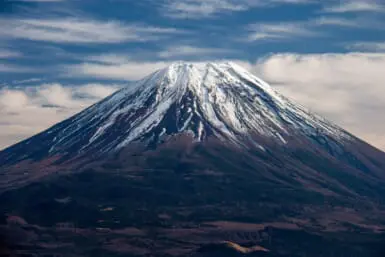If you were to fly over Mageshima, an uninhabited island 20 miles south of Kyushu, you’d likely be struck by the bizarre sight below you. The approximately three-square-mile outcrop of land is lush with trees, save for a barren area running through its heart in the shape of a crucifix, far too uniform to have been crafted by Mother Nature. It’s a dark irony that this symbol of human redemption is yet another sign of our wanton disregard for the natural world.
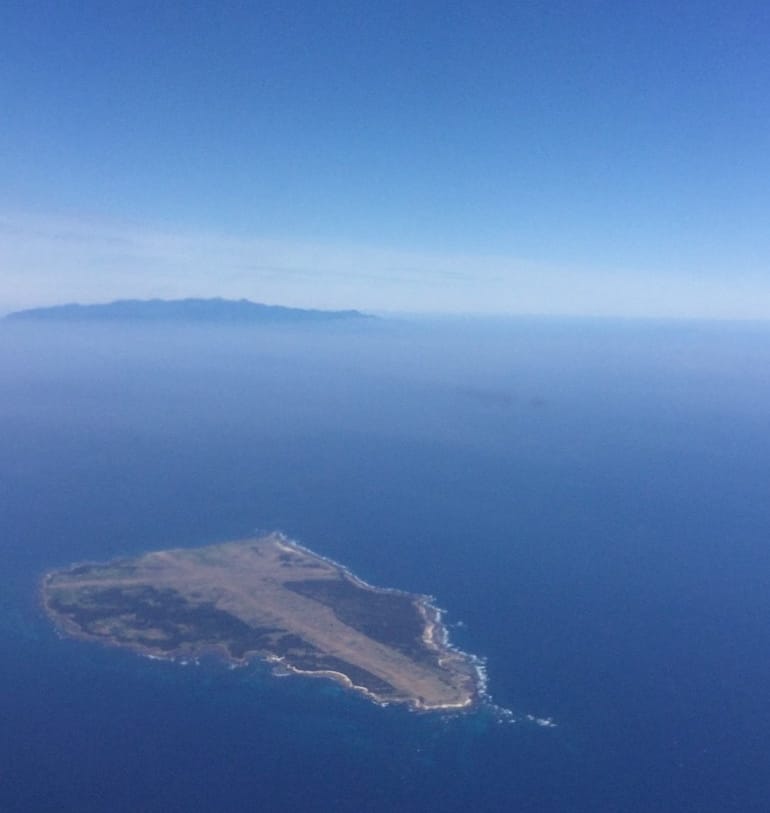
The distance between Yakushima (back) and Mageshima (front) is about 41km. Photographed by Hiromi Nagano. Courtesy of the documentary crowdfunding campaign.
Millenia of little outside interference left Mageshima in a state of raw, biodiverse beauty. Awash in frequent subtropical rainfall, the island gave rise to giant ferns and indigenous cycads. It charted the course for 16 individual rivers despite its small size, and became a temporary and permanent home for rare avian species.
Far from the island, in Japan’s corporate boardrooms, however, the island’s tumultuous recent history has been plotted. For the last half-century, Mageshima has played pawn in a game of bureaucratic chess. It was first identified as a tourist site (Mage Marine Leisure Land), then a potential Japan Self-Defence Force radar base, an oil and nuclear waste storage site under the ownership of Heiwa Sogo Bank and finally a landing site for the HOPE space shuttle upon Tokyo-based developer Taston Airport’s purchase of 99.6% of the island in 1995. (Taston Airport eventually razed 40% of Mageshima’s forest to grade a pair of runways – the aforementioned crucifix of land – exceeding their clearing permit by more than 100 hectares.)
The most recent move for Mageshima could be checkmate. In March 2019, Taston Airport agreed to sell the land back to the Japanese government for approximately 16 billion yen ($146 million) in taxpayer money. The island is now set for a military base on which the US navy – still ever-present in Japan 75 years after World War II concluded – can conduct Field Carrier Landing Practice (FCLP) drills.
There could be severe societal costs for the residents of Mageshima’s neighboring islands. But for the flora and fauna on Mageshima island, the death knell has begun to toll.
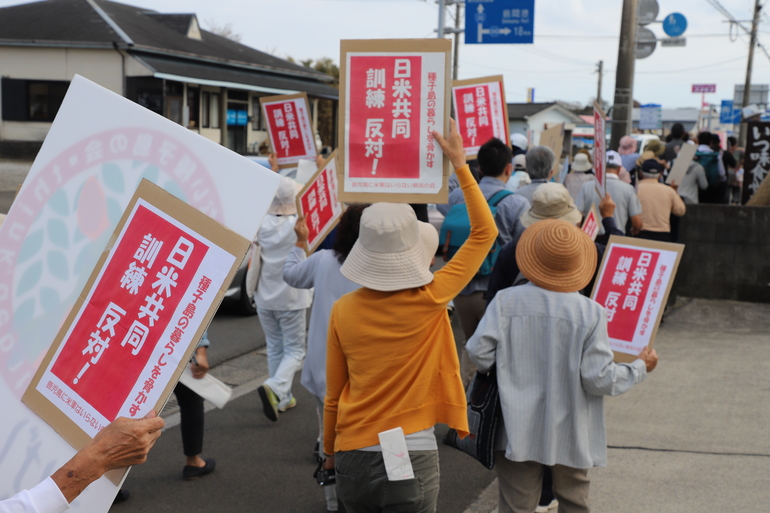
Tanegashima citizens march against Japan-US joint training. October 2018, Nakatane Town, Tanegashima. Photo courtesy of the documentary crowdfunding campaign.
Protests and Opposition
On the evening of March 27, 2021, as the early-blooming sakura swarmed the Kanda River banks in central Tokyo, a contrasting sight charged along the adjacent streets. A group of protestors, perhaps no more than 75-strong, heralded the dangers of the US airbase, tentatively scheduled for completion by 2023. The cries in unison of “stop the base” were the antithesis of the formal and rigid behaviors one usually observes on the streets of Tokyo’s business districts.
One of the protestors was Takashi Kawamura, an artist and filmmaker residing in Yakushima – a World Heritage-designated island 26 miles or 41 kilometers south of Mageshima. Kawamura is making a crowd-funded documentary in opposition to the base “to show the citizens of Japan what is happening to our country in the name of national defense,” he says. “The documentary will be made in desperation of our situation. We can no longer fight this cause at a local level; it needs to be moved up to the national level.”
There are myriad grounds for such opposition: noise pollution from jet crafts and its effect on local fisheries and livestock, the destruction of Mageshima’s unique natural environment, deterioration of public security with Tanegashima becoming a possible future military target and the creation of a rift between local residents. The latter of these issues has become particularly contentious on neighboring Tanegashima island where some are in favor of the base for economic reasons.
Although quietly, local public fervor has been growing since 2007 following reports of Taston Airport secretly grading Mageshima to market it as an FCLP location. By 2011 a formal letter of opposition had been penned to then-Defence Minister Toshimi Kitazawa; the same year a local fishing union issued a lawsuit for damages. The recent mayoral election of anti-base advocate Yaita Shunsuke in Nishinoomote – the northern region of Tanegashima and administrative center for Mageshima – only served to reignite what has been a near-15-year campaign.

Photo courtesy of the documentary crowdfunding campaign
The Endangered Species of Mageshima
The Mageshika, an endemic subspecies of deer on the red list of endangered fauna, will be one of the primary victims of the airbase. The deer population has slowly dwindled since 2000, thanks in part to the Taston Airport debacle, falling from 570 to 280 by 2011. (A re-investigation of the population was conducted on March 10 this year, but the results are currently under analysis.)
Mageshima is also a spawning ground for endangered loggerhead and green turtles whose reproductive behavior is highly affected by noise and light at night – the FCLP drills are permissible until 3am in the current plans. The island’s namesake horsehair crab (Mage means “horsehair”), hosoba arino togusa, is an endemic species only found on Mageshima and teetering on the brink of extinction. Mageshima is also a relay destination for rare migratory birds who may struggle to roost on the island following the construction. And there could be untold complications for flying fish and other marine life populations due to polluted sediments and chemical spills from the base.
In Yakushima, a treasure of the nation and one of the most biodiverse patches of land north of the tropics, a prospective secondary landing strip – to be used in the event of Mageshima’s base becoming unavailable – could cause environmental tremors of its own. The flora and fauna of Yakushima were already dealing with the shock of the island’s pre-pandemic rise in inbound tourists; issues that may exacerbate with the frequent din of carrier jets and increased ease of access for off-duty soldiers.
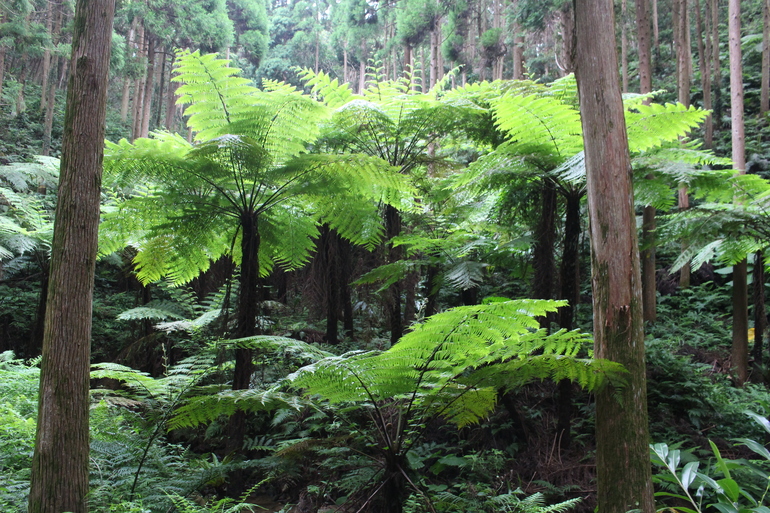
Bonin tree ferns of Tanegashima (Cultural property designated by Nishinoomote City / Natural monument). September 2019, Kunigami, Nishinoomote City. Photo courtesy of the documentary crowdfunding campaign.
Lessons Not Learned from Okinawa
In 2016 it was reported the US military had polluted Okinawa’s drinking water – later believed to have affected a third of the population – following the discharge of tens of thousands of liters of firefighting foam (which was blamed on a malfunctioning sprinkler system). The ingestion of the chemicals in question, per- and polyfluoroalkyl substances (PFAs), is linked to a litany of maladies, from cancers of the internal organs to severe immunological defects.
Despite that, as of last year, Japanese government officials were still waiting for permission to inspect the offending Kadena Air Base. The story typifies the worrying nature of the US military’s ability to self-police in Japan, and highlights their continued exertion of soft power.
Takeshi Kawamura echoes this sentiment: “The US military has rights to unregulated flight courses and has the right to arrest and convict their personnel when crimes such as sexual assault are committed upon Japanese soil. The US-Japan Status of Forces Agreement is heavily in favor of the US military, but the Japanese Government is a compliant partner,” he says. “Our Government is putting the requests of the US military above that of its own citizens”.
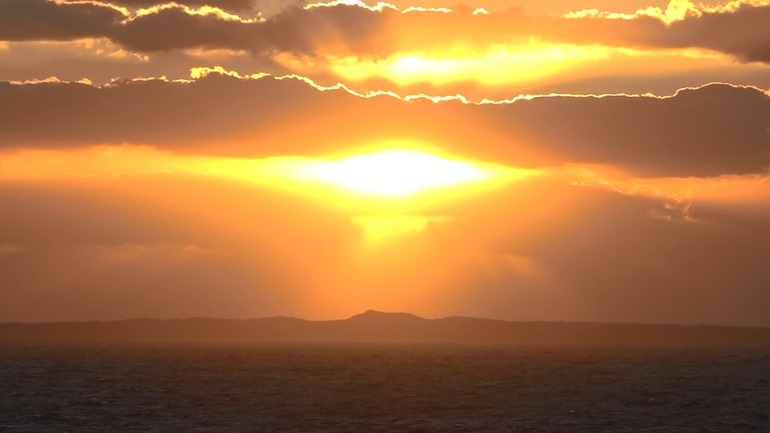
Mageshima and the setting sun. October 2019, Osaki, Nishinoomote City. Photo courtesy of the documentary crowdfunding campaign.
The residents of the subtropics of Kyushu exist in great harmony with their environment. The planned base on Mageshima, and all the mishandled bureaucracy, corporate greed and issues of national defense surrounding it, represent a severing of this interdependent connection. Unfortunately, so much complexity flies in the face of simple resolution.
“I don’t know if the decision [to build the base] can be reversed,” admits Kawamura. “But if we don’t try, then it certainly won’t be reversed, and we would live knowing that we did nothing to stop it as the jets fly over our island.”
The documentary “Protect the Island” with English translation is set for release circa late-2022. You can support the production through a crowdfunding campaign (as of the time of writing, the team is ¥330,000 shy of their fundraising target), and can keep up-to-date with the story via the Save Mageshima Facebook page.
Top image: Japanese Ground Self-Defense Force remote island recapture unit “Amphibious Rapid Deployment Brigade” and AAV amphibious vehicle. November 2019, Maenohama, Minamitane Town, Tanegashima. Photo courtesy of the documentary crowdfunding campaign.


